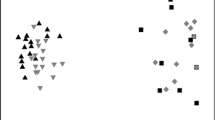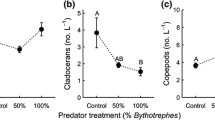Abstract
The strength of trophic cascade effects in aquatic ecosystems depend, in part, on the identity of the top predator involved. We examined whether an invasive benthic fish (round goby, Neogobius melanostomus) altered the strength of cascade effects in a heterotrophic stream and in a controlled mesocosm experiment relative to the effects of a functionally similar, native fish. In the stream, the introduced fish had a direct effect on grazer and shredder abundance which led to a significant increase in periphyton chlorophyll a, a significant reduction in leaf breakdown rate, an increase in leaf biomass remaining, but no change in periphyton ash-free dry mass. In mesocosms, native and introduced fish similarly reduced shredder abundance, but this did not lead to an indirect effect on leaf breakdown rates or biomass remaining at the end of the experiment. Indirect effects of introduced fish on periphyton biomass and chlorophyll a in mesocosms were both significant and were stronger than in the field, but were the result of grazer behavioral modification and not reduced grazer abundance. Collectively, these results suggest non-native fish have the ability to initiate trophic cascades in heterotrophic streams, and that both fish identity and environmental context are important in determining the strength of cascades.









Similar content being viewed by others
References
Acquistapace P, Hazlett BA, Gherardi F (2003) Unsuccessful predation and learning of predator cues by crayfish. J Crust Biol 23:364–370
Balshine S, Verma A, Chant V, Theysmeyer T (2005) Competitive interactions between round gobies and logperch. J Gt Lakes Res 31:68–77
Banks PB, Dickman CR (2007) Alien predation and the effects of multiple levels of prey naiveté. Trends Ecol Evol 22:229–230
Barton DR, Reagan A, Johnson J, Campbell L, Petruniak J, Patterson M (2005) Effects of round gobies (Neogobius melanostomus) on dreissenid mussels and other invertebrates in Eastern Lake Erie, 2002–2004. J Gt Lakes Res 31(Suppl. 2):252–261
Baxter CV, Fausch KD, Murakami M, Chapman PL (2004) Fish invasion restructures stream and forest food webs by interrupting reciprocal prey subsidies. Ecology 85:2656–2663
Benfield EF (2007) Decomposition of leaf material. In: Hauer FR, Lamberti GA (eds) Methods in stream ecology, 2nd edn. Academic Press, London, pp 711–720
Beschta RL, Ripple WJ (2009) Large predators and trophic cascades in terrestrial ecosystems of the western United States. Biol Conserv 142:2401–2414
Biggs JF, Francoeur SN, Huryn AD, Young R, Arbuckle CJ, Townsend CR (2000) Trophic cascades in streams: effects of nutrient enrichment on autotrophic and consumer benthic communities under two different fish predation regimes. Can J Fish Aquat Sci 57:1380–1394
Bode RW, Novak MA, Abele LE, Heitzman DL, Smith AJ, Carlson D (2002) Ellicott Creek biological assessment, 2001 survey. Stream Biomonitoring Unit, Bureau of Watershed Assessment and Research, Division of Water, NY Dept of Environmental Conservation. 43 pp
Borer ET, Seabloom EW, Shurin JB, Anderson KE, Blanchette CA, Broitman B, Cooper SD, Halpern BS (2005) What determines the strength of a trophic cascade? Ecology 86:528–537
Brown GE (2003) Learning about danger: chemical alarm cues and local risk assessment in prey fishes. Fish Fish 4:227–234
Buria L, Alboariño R, Díaz Villanueva V, Modenutti B, Balseiro E (2010) Does predation by the introduced rainbow trout cascade down to detritus and algae in a forested small stream in Patagonia? Hydrobiologia 651:161–172
Carman SM, Janssen J, Jude DJ, Berg MB (2006) Diel interactions between prey behaviour and feeding in an invasive fish, the round goby, in a North American river. Freshw Biol 51:742–755
Carpenter SR, Kitchell JF, Hodgson JR (1985) Cascading trophic interactions and lake productivity. BioScience 35:634–639
Casini M, Hielm J, Molinero JC, Lövgren J, Cardinale M, Bartolino V, Belgrano A, Kornilovs G (2009) Trophic cascades promote threshold-like shifts in pelagic marine ecosystems. Proc Natl Acad Sci 106:197–202
Chalcraft DR, Resetarits WJ Jr (2003) Predator identify and ecological impacts: functional redundancy or functional diversity? Ecology 84:2407–2418
Chivers DP, Smith RJF (1998) Chemical alarm signaling in aquatic predator–prey systems: a review and prospectus. Ecoscience 5:338–352
Cooper SD, Smith DW, Bence JR (1985) Prey selection by freshwater predators with different foraging strategies. Can J Fish Aquat Sci 42:1720–1732
Cooper SD, Walde SJ, Peckarsky BL (1990) Prey exchange rates and the impact of predators on prey populations in streams. Ecology 71:1503–1514
Copp GH, Bianco PG, Bogutskaya N, Erös T, Falka I, Ferreira MT, Fox MG, Freyhof J, Gozlan RE, Grabowska J, Kováč V, Moreno-Amich R, Naseka AM, Peňáz M, Povž M, Przybylski M, Robillard M, Russell IC, Stakénas S, Šumer S, Vila-Gispert A, Wiesner C (2005) To be, or not to be, a non-native freshwater fish? J Appl Ichthyol 21:242–348
Corkum LD, Sapota MR, Skora KE (2004) The round goby, Neogobius melanostomus, a fish invader on both sides of the Atlantic Ocean. Biol Invasion 6:173–181
Cox JG, Lima SL (2006) Naiveté and an aquatic–terrestrial dichotomy in the effects of introduced predators. Trends Ecol Evol 21:674–680
Daskalov GM, Grishin AN, Rodionov S, Mihneva V (2007) Trophic cascades triggered by overfishing reveal possible mechanisms of ecosystem regime shifts. Proc Natl Acad Sci 104:10518–10523
Dick J, Platvoet D (1996) Intraguild predation and species exclusions in amphipods: the interaction of behaviour, physiology and environment. Freshw Biol 36:375–383
Dill LM, Fraser AGH (1997) The worm returns: hiding behavior of a tube dwelling marine polychaete, Serpula vermicularis. Behav Ecol 8:186–193
Fischer AM (2014) Effects of round goby presence on invertebrate and microbial communities in decaying leaf matter of a Lake Erie tributary stream. Biology Theses 12. http://digitalcommons.buffalostate.edu/biology_theses/12
Fuller P, Benson A, Maynard E, Neilson M, Larson J, Fusaro A (2017) Neogobius melanostomus. USGS Nonindigenous Aquatic Species Database, Gainesville, FL. https://nas.er.usgs.gov/queries/factsheet.aspx?SpeciesID=713. Revision date 1/7/2016
Greig HS, McIntosh AR (2006) Indirect effects of predatory trout on organic matter processing in detritus-based stream food webs. Oikos 112:31–40
Gutowsky LFG, Fox MG (2011) Occupation, body size, and sex ratio of round goby (Neogobius melanostomus) in established and newly invaded areas of an Ontario river. Hydrobiologia 671:27–37
Harter HL (1961) Expected values of normal order statistics. Biometrika 48:151–165
Hoverman JT, Auld JR, Relyea RA (2005) Putting prey back together again: integrating predator-induced behavior, morphology, and life history. Oecologia 144:481–491
Huffaker CB (1958) Experimental studies on predation: dispersion factors and predator–prey oscillations. Hilgardia 27:343–383
Kipp R, Ricciardi A (2012) Impacts of the Eurasian round goby (Neogobius melanostomus) on benthic communities in the upper St. Lawrence River. Can J Fish Aquat Sci 69:469–486
Konishi M, Nakano S, Iwata T (2001) Trophic cascading effects of predatory fish on leaf litter processing in a Japanese stream. Ecol Res 16:415–422
Kornis MS, Vander Zanden MJ (2010) Forecasting the distribution of the invasive round goby (Neogobius melanostomus) in Wisconsin tributaries to Lake Michigan. Can J Fish Aquat Sci 67:553–562
Krakowiak PJ, Pennuto CM (2008) Fish and macroinvertebrate communities in tributary streams of Eastern Lake Erie with and without round gobies (Neogobius melanostomas, Pallas 1814). J Gt Lakes Res 34:675–689
Lauer TE (2004) Changes in mottled sculpin and Johnny darter trawl catches after the appearance of round gobies in the Indiana waters of Lake Michigan. Trans Am Fish Soc 133:185–189
Lima SL, Dill LM (1990) Behavioral decisions made under the risk of predation: a review and prospectus. Can J Zool 68:619–640
McPeek MA (1990) Behavioral differences between Enallagma species (Odonata) influencing differential vulnerability to predators. Ecology 71:1714–1726
Mikl L, Adámek Z, Všetičková Janáč M, Roche K, Šlapansky L, Jurajda P (2017) Response of benthic macroinvertebrate assemblages to round (Neogobius melanostomus, Pallas 1814) and tubenose (Proterorhinus semilunaris, Heckel 1837) goby predation pressure. Hydrobiologia 785:219–232
Nilsson E, Olsson K, Persson A, Nyström P, Svensson G, Nilsson U (2008) Effects of stream predator richness on the prey community and ecosystem attributes. Oecologia 157:641–651
Pagnucco KS, Yasmina R, Ricciardi A (2016) An invasive benthic fish magnifies trophic cascades and alters pelagic communities in an experimental freshwater system. Freshw Sci 35:654–665
Peckarsky BL, McIntosh AR (1998) Fitness and community consequences of avoiding multiple predators. Oecologia 113:565–576
Peckarsky BL, Cowan CA, Anderson CR (1994) Consequences and plasticity of the specialized predatory behavior of stream-dwelling stonefly larvae. Ecology 75:166–181
Pennuto CM (2003) Seasonal differences in predator–prey behavior in experimental streams. Am Midl Nat 150:254–267
Pennuto CM, Keppler DA (2008) Short-term predator avoidance behavior by invasive and native amphipods in the Great Lakes. Aquat Ecol 42:629–641
Pennuto CM, Krakowiak PJ, Janik CE (2010) Diet, energy consumption, and seasonal abundance of round gobies (Neogobius melanostomus) in Lake Erie, USA tributary streams. Ecol Freshw Fish 19:206–215
Poos M, Dextrase A, Schwalb A, Ackerman J (2010) Secondary invasion of the round goby into high diversity Great Lakes tributaries and species at risk hotspots: potential new concerns for endangered freshwater species. Biol Invasions 12:1269–1284
Preisser EL, Bolnick DI, Benard MF (2005) Scared to death? The effects of intimidation and consumption in predator–prey interactions. Ecology 86:501–509
Ruetz CR III, Newman RM, Vondracek B (2002) Top-down control in a detritus-based food web: fish, shredders, and leaf breakdown. Oecologia 132:307–315
Schmitz OJ (2010) Resolving ecosystem complexity. Monographs in population biology, No. 47. Princeton Univeristy Press, Princeton
Shurin JB, Borer ET, Seabloom EW, Anderson K, Blanchette CA, Broitman B, Cooper SD, Halpern BS (2002) A cross-ecosystem comparison of the strength of trophic cascades. Ecol Lett 5:785–791
Sih A, Bolnick DI, Luttbeg B, Orrock JL, Peacor SD, Pintor LM, Preisser E, Rehage JS, Vonesh JR (2010) Predator–prey naïveté, antipredator behavior, and the ecology of predator invasions. Oikos 119:610–621
Simon KS, Townsend CR (2003) Impacts of freshwater invaders at different levels of ecological organisation, with emphasis on salmonids and ecosystem consequences. Freshw Biol 48:982–994
Steinman AD, Lamberti GA, Leavitt PR (2007) Biomass and pigments of benthic algae. In: Hauer FR, Lamberti GA (eds) Methods in stream ecology, 2nd edn. Academic Press, London, pp 357–379
Tomba AM, Keller TA, Moore PA (2001) Foraging in complex odor landscapes: chemical orientation strategies during stimulation by conflicting chemical cues. J North Am Benthol Soc 20:211–222
Turner AM (1996) Freshwater snails alter habitat use in response to predation. Anim Behav 51:747–756
Turner AM, Bernot RJ, Boes CM (2000) Chemical cues modify species interactions: the ecological consequences of predator avoidance by freshwater snails. Oikos 88:148–158
van Beek CW (2006) The round goby Neogobius melanostomus first recorded in the Netherlands. Aquat Invasions 1:42–43
Wallach AD, Ripple WJ, Carroll SP (2015) Novel trophic cascades: apex predators enable coexistence. Trends Ecol Evol 30:146–153
Weimer MT (2003) The distribution of round goby (Neogobius melanostomus) in Eighteenmile Creek, Erie County, New York. Aquat Invader 14:2–4
Woodward G, Papantoniou G, Edwards F, Lauridsen RB (2008) Trophic trickles and cascades in a complex food web: impacts of a keystone predator on stream community structure and ecosystem processes. Oikos 117:683–692
Acknowledgements
Parts of this research were supported by an NSF, URM award (DEB No. 0731582) to CMP and supporting CEJ. Special thanks to the BSC Field Station manager, Mark Clapsadl, for securing the mesocosm location and logistics.
Author information
Authors and Affiliations
Corresponding author
Rights and permissions
About this article
Cite this article
Pennuto, C.M., Cudney, K.A. & Janik, C.E. Fish invasion alters ecosystem function in a small heterotrophic stream. Biol Invasions 20, 1033–1047 (2018). https://doi.org/10.1007/s10530-017-1609-8
Received:
Accepted:
Published:
Issue Date:
DOI: https://doi.org/10.1007/s10530-017-1609-8




